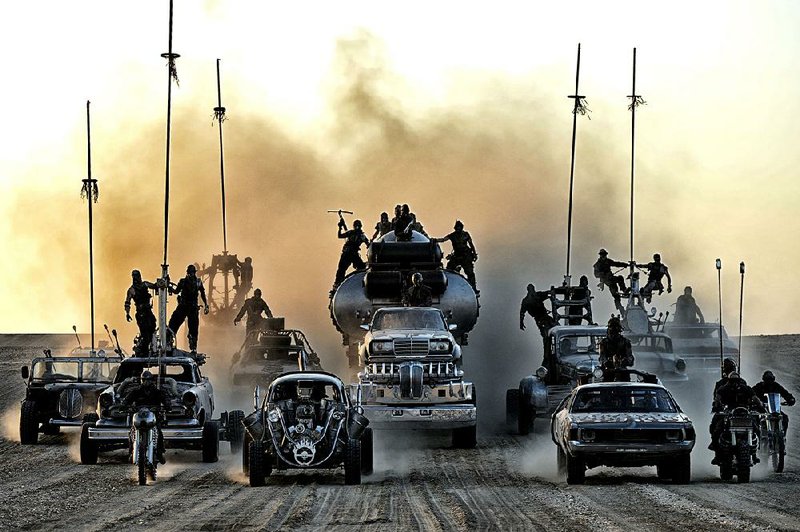I'm not sure there's a whole lot to be gained by thinking too deeply about dystopian action movies, but having seen George Miller's remarkable Mad Max: Fury Road I thought I might jot down a few notes before it slides painlessly from my mind.
I am old enough to have seen the original Mad Max in theaters (Mel Gibson's lines were dubbed by an American actor) and to remember my reaction to it. It struck me as a raw and foreign thing, seedy and dangerous, like contraband. It felt like something I wasn't supposed to see, something that might cause its viewers mortal injury.
If I wanted to assert my coolness, I suppose I would say I loved it. The truth is my reaction was more complicated. I was sophisticated enough to know that, no matter how crude and incoherent it seemed, Mad Max was still a movie, a kind of business venture. It was a collaborative effort; hundreds of people had bought in to a singular idea to make the thing because they thought people would find it entertaining. I understood it was all artificial, which made it all the more unnerving. It was hard for me to understand why anyone would want to make something so ugly.
Yet it had an undeniable appeal. An unwholesome appeal. Despite the evident skill that went into the film, it felt like the work of amateurs, a sort of punk-rock revenge movie bashed out in a garage by gleeful idiots. I had no idea who Miller was -- I had only the vaguest idea of what a director did -- but it felt like the kind of movie anyone could make provided they were afflicted with the requisite obsessions and madness.
Most Americans saw The Road Warrior -- Mad Max 2 to the rest of the world-- which came out in 1981 before they saw the original Mad Max. It had a bigger budget, and all in all is probably a better movie. It certainly looks better, and there's minimally more story and dialogue than in the famously terse original. It's also further removed from realism -- we learn at the beginning, in a voice-over from the grown-up version of the Feral Kid, that it's "storytelling, fable, mythology."
I wasn't terribly enthusiastic about it at the time, although it received some great reviews. (Roger Ebert especially liked it.) It felt more like a movie to me, stylish and artificial. When Mad Max Beyond Thunderdome arrived in 1985, I was only marginally interested. These weren't really my kind of movies; I could take them or leave them.
And so it took me a couple of weeks to get around to seeing Fury Road, and I watched primarily out of a sense of professional obligation. (Not that I didn't think I'd enjoy the movie -- I suspected I would and I did -- it's just that there are lots of ways we can spend our time, and watching other people's dreams unfold on screen is just one of them.)
What's remarkable about Fury Road has a lot more to do with the architecture of the frame and Miller's delight in throwing things right at the face of the audience than any sneaky feminism. There's a kind of kinetic genius to the movie, which is essentially one long chase. As usual, Miller keeps his characters, particularly the titular Max, played by the charismatic and canny Tom Hardy, taciturn and his plot uncluttered.
The feminism that some have perceived in the movie is largely supplied by grace notes -- Charlize Theron gets to be a competent warrior and, perhaps more importantly, she gets to drive, but her cargo consists of a warlord's impossibly beautiful sex slaves. Damsels get rescued, and Max eventually saves the day while staying true to the character's established persona; he remains the solitary loner impelled to drift and survive.
None of that bothers me; Fury Road is a big-budget big-deal movie, and it's not going to stray too far from the template. Girls get to kick butt, and Theron's Furiosa is arguably a showier part than Hardy's Max, but the chief virtues of the movie have to do with the way it engages us on a visceral level. It's a thrill ride. And there's nothing wrong with that.
Yet I'm a little disappointed in how easily I received the film. It feels exactly like what it is, a big-ticket Hollywood actioner with just enough "intellectual" material sprinkled in to get people like me talking and writing about it. It's well-designed and realized. It's a professional production. There's nothing sketchy about it.
Call it nostalgia, but I miss the days when something could penetrate our cultural firewall and actually upset us. When we'd occasionally have the feeling of apprehending real danger in the cineplex.
Email:
pmartin@arkansasonline.com
MovieStyle on 06/05/2015
